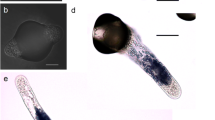Abstract
The processes of rounding (spheration) and cell wall formation of extracellular protoplasm fragments ofBoergesenia forbesii were examined. This spheration depended on the presence of Ca2+ in the medium, and was accelerated exponentially with increasing temperature up to 35 C. At 25 C the regenerated cell wall could be detected within 3 hr, after the release of protoplasm into Provasoli's ES-medium.
Germination, the development of a protrusion from the round cell, had an optimal temperature of 30 C and was interrupted at temperatures below 17 C. The germination was promoted by red-light irradiation (a maximum around 625 nm). This promotion depended on both irradiation time and light intensity, and was diminished by DCMU. Therefore, it was concluded that this promotion was caused predominantly through photosynthetic activity.
The rhizoidal protrusion developed on the shaded side of a unilaterally irradiated round cell. Blue light was most effective in inducing cell polarity with light of wavelengths longer than 600 nm being ineffective. This wavelength-dependency was similar to that observed for polarity induction ofFucus eggs or in phototropism ofAvena coleoptiles.
Similar content being viewed by others
References
Banbury, G.H. 1959. Phototropism of lower plants.In: E. Bunning, ed., Encyclopedia of Plant PhysiologyXVII/1: 530–478. Springer-Verlag, Berlin.
Bertsch, W.F. 1963. The photoinhibition of growth in etiolated stem segments. III. Farred reversibility of blue light effect inPisum. Amer. J. Bot.50: 754–760.
Black, M. 1969. Light-controlled germination of seed. Symp. Soc. Exp. Biol.23: 193–217.
Briggs, W.R. 1976. The nature of the blue light photoreceptor in higher plants and fungi.In: H. Smith, ed., Light and Plant Development. Proceedings of the 22nd Nottingham Easter School in Agricultural Sciences p. 7–18. Butterworths, London.
Enomoto, S. andH. Hirose. 1972. Culture studies on artificially induced aplanospores and phyceae, Siphonocladales). Phycologia11: 119–122.
Haupt, W. 1965. Perception of environmental stimuli orienting growth and movement in lower plants. Ann. Rev. Plant Physiol.16: 267–290.
Hurd, A.M. 1920. Effect of unilateral monochromatic light and group orientation on the polarity of germinatingFucus spores. Bot. Gaz.70: 25–50.
Jaffe, L.F. 1985a. Tropistic responses of zygotes of the Fucaceae to polarized light. Exp. Cell Res.15: 282–299.
— 1958b. Morphogenesis in lower plants. Ann. Rev. Plant Physiol.8: 359–384.
—. 1962. Orientation and locus of tropic photoreceptor molecules in spores ofBotrytis andOsmunda. J. Cell Biol.13: 13–31.
—. 1965. Tropic responses ofFunaria spores to red light. Biophys. J.5: 715–742.
Mayer zu Bentrup, F.W. 1963. Vergleichende Untersuchungen zur Polaritätsinduktion durch das Licht an derEquisetumspore und derFucuszygote. Planta59: 472–491.
Mohr, H. 1972. Lectures on Photomorphogenesis. Springer-Verlag, Berlin.
Pjon, C.J. andM. Furuya. 1967. Phytochrome action inOryza sativa L. I. Growth responses of etiolated coleoptiles to red, far-red and blue light. Plant Cell Physiol.8: 709–718.
Provasoli, L. 1966. Media and prospects for the cultivation of marine algae.In: A. Watanabe and A. Hattori, ed., Cultures and Collections of Algae p. 63–75. Proc. US-Japan Conf. Hakone.
—. 1974. Vitamins and growth regulators.In: W.D.P. Stewart, ed., Algal Physiology and Biochemistry p. 741–787. Blackwell Scientific Publ., Oxford.
Schwabe, W.W. andI.F.M. Valio. 1970. Growth and dormancy inLunularia cruciata (L.) Dum. VI. Growth regulation by daylength, by red, far-red, and blue light, and by applied growth regulators and chelating agents. J. Exp. Bot.21: 122–137.
Sugai, M. 1971. Photomorphogenesis inPteris vittata. IV. Action spectra for inhibition of phytochrome-dependent spore germination. Plant Cell Physiol.21: 103–109.
Tatewaki, M. andK. Nagata. 1970. Surviving protoplastsin vitro and their development inBryopsis. J. Phycol.6: 401–403.
Thimann, K.V. andG.H. Curry. 1960. Phototropism and phototaxis. Comparative Biochemistry1: 243–309.
Towill, L.R. andH. Ikuma. 1973. Photocontrol of the germination ofOnoclea spores. I. Action spectrum. Plant Physiol.51: 973–978.
Author information
Authors and Affiliations
Rights and permissions
About this article
Cite this article
Ishizawa, K., Enomoto, S. & Wada, S. Germination and photo-induction of polarity in the spherical cells regenerated from protoplasm fragments ofBoergesenia forbesii . Bot Mag Tokyo 92, 173–186 (1979). https://doi.org/10.1007/BF02497929
Received:
Issue Date:
DOI: https://doi.org/10.1007/BF02497929




